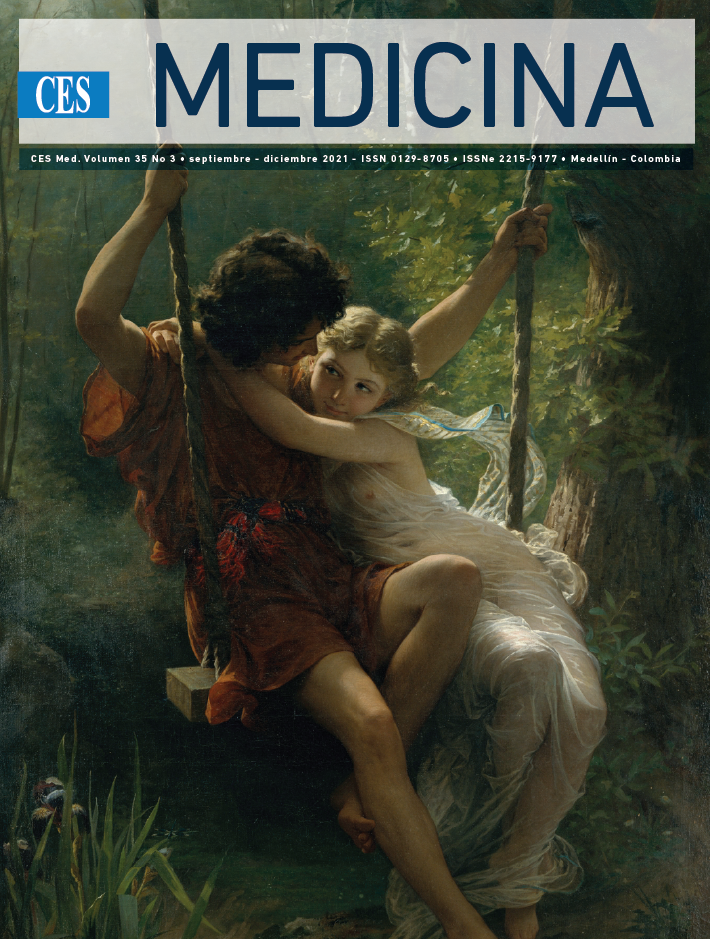Prescription profile of antiarrhythmic drugs in a group of patients in Colombia
DOI:
https://doi.org/10.21615/cesmedicina.5308Keywords:
adrenergic beta-antagonists, anti-arrhythmic agents, atrial fibrillation, long QT syndrome, arrhythms cardiacAbstract
Objective: To determine the prescription patterns of antiarrhythmic drugs and variables associated with their use in a population of patients affiliated with the Colombian Health System. Methods: A cross-sectional study was performed on a population database with patients who received antiarrhythmics from March to May 2016. Sociodemographic, pharmacological and comedication variables were included. SPSS-24 was used for data analysis using X2 tests and multivariate analyses. Results: In total, 2772 patients were treated with antiarrhythmics in the evaluated period. The mean age was 70.1 ± 13.1 years, and 51.2% were women. In total, 79.4% used a β-blocker, 58.5% amiodarone and 2.9% a calcium channel blocker. Moreover, 1192 (43.0%) patients were prescribed a single antiarrhythmic, and 1580 (57.0%) received two or more. There were 2603 patients (93.9%) with comedication, including lipid-lowering drugs (62.6%), inhibitors of the renin angiotensin aldosterone system (62.6%) and antiplatelet drugs (42.0%). Age older than 65 years increased the probability of comedication (odds ratio [OR]: 2.48; 95% confidence interval [95% CI]: 1.59-3.85), and the risk was proportional to age. We identified 1364 patients treated with conditional risk medications for QT prolongation (49.2%), 68 with a possible risk (2.5%) and 171 (6.2%) with a known risk. Conclusion: Antiarrhythmic drugs recommended by clinical practice guidelines are mainly used; however, risk interactions of QT prolongation were identified and should be taken into account by physicians to avoid adverse events or complications.
Downloads
References
Gaztañaga L, Marchlinski FE, Betensky BP. Mechanisms of Cardiac Arrhythmias. Rev Esp Cardiol (English Edition). 2012;65(2):174-85.
López Soto A, Formiga F, Bosch X, García Alegría J. Prevalencia de la fibrilación auricular y factores relacionados en pacientes ancianos hospitalizados: estudio ESFINGE. Med Clin. 2012;138(6):231-7.
January CT, Wann LS, Calkins H, Chen LY, Cigarroa JE, Cleveland JC, Jr., et al. 2019 AHA/ACC/HRS Focused Update of the 2014 AHA/ACC/HRS Guideline for the Management of Patients With Atrial Fibrillation: A Report of the American College of Cardiology/American Heart Association Task Force on Clinical Practice Guidelines and the Heart Rhythm Society in Collaboration With the Society of Thoracic Surgeons. Circulation. 2019;140(2):e125-e51.
Moro Serrano C, Hernández-Madrid A. Fibrilación auricular: ¿estamos ante una epidemia? Rev Esp Cardiol. 2009;62(01):10-4.
Stewart S, Murphy N, Walker A, McGuire A, McMurray JJV. Cost of an emerging epidemic: an economic analysis of atrial fibrillation in the UK. Heart. 2004;90(3):286-92.
Jaimes M, Guzmán S, Moreno C, Llano A, Trujillo A. Análisis de situación de Salud. Colombia, 2014. Ministerio de Salud y Protección Social. 2014.
Ball J, Carrington MJ, McMurray JJ, Stewart S. Atrial fibrillation: profile and burden of an evolving epidemic in the 21st century. Int J Cardiol. 2013;167(5):1807-24.
Minor S, Akiyama T. Ventricular Arrhythmias in the Elderly. J Arrhythm. 2006;22(1):19-30.
Nguyen TN, Hilmer SN, Cumming RG. Review of epidemiology and management of atrial fibrillation in developing countries. Int J Cardiol. 2013;167(6):2412-20.
Romero M, Chávez D. Carga de enfermedad atribuible a fibrilación auricular en Colombia (2000-2009). Rev Col Cardiol. 2014;21(6):374-81.
Godoy VC, Planas JM, Castellano NP, Cavazos RF, Macaya C, Villacastín JP. ¿Hay un lugar para los fármacos antiarrítmicos? Rev Esp Cardiol. 2010;10, Supplement 1:69A-77A.
Woosley RL, Heise CW, Romero KA. QTdrugs List, AZCERT, Inc. 1822 Innovation Park Dr., Oro Valley, AZ 85755, USA. Available at: www.Crediblemeds.org
Chow GV, Marine JE, Fleg JL. Epidemiology of arrhythmias and conduction disorders in older adults. Clin Geriatr Med. 2012;28(4):539-53.
Strait JB, Lakatta EG. Aging-associated cardiovascular changes and their relationship to heart failure. Heart Fail Clin. 2012;8(1):143-64.
Curtis AB, Narasimha D. Arrhythmias in women. Clin Cardiol. 2012;35(3):166-71.
Olshansky B, Rosenfeld LE, Warner AL, Solomon AJ, O'Neill G, Sharma A, et al. The Atrial Fibrillation Follow-up Investigation of Rhythm Management (AFFIRM) study: approaches to control rate in atrial fibrillation. J Am Coll Cardiol. 2004;43(7):1201-8.
Michaud GF, Stevenson WG. Atrial Fibrillation. N Engl J Med. 2021;384(4):353-61.
Hindricks G, Potpara T, Dagres N, Arbelo E, Bax JJ, Blomstrom-Lundqvist C, et al. 2020 ESC Guidelines for the diagnosis and management of atrial fibrillation developed in collaboration with the European Association for Cardio-Thoracic Surgery (EACTS): The Task Force for the diagnosis and management of atrial fibrillation of the European Society of Cardiology (ESC) Developed with the special contribution of the European Heart Rhythm Association (EHRA) of the ESC. Eur Heart J. 2021;42(5):373-498.
Priori SG, Blomström-Lundqvist C, Mazzanti A, Blom N, Borggrefe M, Camm J, et al. Guía ESC 2015 sobre el tratamiento de pacientes con arritmiasventriculares y prevención de la muerte súbita cardiaca. Rev Esp Cardiol. 2016;69(2):176.e1-.e77.
Vaughan-Sarrazin MS, Mazur A, Chrischilles E, Cram P. Trends in the pharmacologic management of atrial fibrillation: Data from the Veterans Affairs health system. Am Heart J. 2014;168(1):53-9 e1.
Medina-Morales DA, Machado-Duque ME, Gaviria-Mendoza A, Carvajal-Varon AF, Machado-Alba JE. Clinical characteristics and stratification of the cerebrovascular accident risk among patients with atrial fibrillation in Colombia, 2011-2016. Expert Rev Cardiovasc Ther. 2021;19(2):181-7.
Kirchhof P, Camm AJ, Goette A, Brandes A, Eckardt L, Elvan A, et al. Early Rhythm-Control Therapy in Patients with Atrial Fibrillation. N Engl J Med. 2020;383(14):1305-16.
García-Seara J, González-Juanatey JR. Epidemiología de la fibrilación auricular y comorbilidades asociadas. Rev Esp Cardiol. 2012;12:3-10.
Anderson TJ, Gregoire J, Hegele RA, Couture P, Mancini GB, McPherson R, et al. 2012 update of the Canadian Cardiovascular Society guidelines for the diagnosis and treatment of dyslipidemia for the prevention of cardiovascular disease in the adult. Can J Cardiol. 2013;29(2):151-67.
Sharma MD, Farmer JA, Garber A. Type 2 diabetes and cardiovascular risk factors. Curr Med Res Opin. 2011;27 Suppl 3:1-5.
Goldschlager N, Epstein AE, Naccarelli GV, Olshansky B, Singh B, Collard HR, et al. A practical guide for clinicians who treat patients with amiodarone: 2007. Heart Rhythm. 2007;4(9):1250-9.
Moreno-Gutierrez PA, Gaviria-Mendoza A, Canon MM, Machado-Alba JE. High prevalence of risk factors in elderly patients using drugs associated with acquired torsades de pointes chronically in Colombia. Br J Clin Pharmacol. 2016;82(2):504-11.
Deneer VH, van Hemel NM. Is antiarrhythmic treatment in the elderly different? a review of the specific changes. Drugs Aging. 2011;28(8):617-33.
Kozik TM, Wung SF. Acquired long QT syndrome: frequency, onset, and risk factors in intensive care patients. Crit Care Nurse. 2012;32(5):32-41.
Vieweg WV, Wood MA, Fernandez A, Beatty-Brooks M, Hasnain M, Pandurangi AK. Proarrhythmic risk with antipsychotic and antidepressant drugs: implications in the elderly. Drugs Aging. 2009;26(12):997-1012.
Downloads
Published
How to Cite
Issue
Section
License
Copyright (c) 2021 CES Medicina

This work is licensed under a Creative Commons Attribution-NonCommercial-ShareAlike 4.0 International License.
Derechos de reproducción (copyright)
Cada manuscrito se acompañará de una declaración en la que se especifique que los materiales son inéditos, que no han sido publicados anteriormente en formato impreso o electrónico y que no se presentarán a ningún otro medio antes de conocer la decisión de la revista. En todo caso, cualquier publicación anterior, sea en forma impresa o electrónica, deberá darse a conocer a la redacción por escrito.
Plagios, duplicaciones totales o parciales, traduccones del original a otro idioma son de responsabilidad exclusiva de los autores el envío.
Los autores adjuntarán una declaración firmada indicando que, si el manuscrito se acepta para su publicación, los derechos de reproducción son propiedad exclusiva de la Revista CES Medicina.
Se solicita a los autores que proporcionen la información completa acerca de cualquier beca o subvención recibida de una entidad comercial u otro grupo con intereses privados, u otro organismo, para costear parcial o totalmente el trabajo en que se basa el artículo.
Los autores tienen la responsabilidad de obtener los permisos necesarios para reproducir cualquier material protegido por derechos de reproducción. El manuscrito se acompañará de la carta original que otorgue ese permiso y en ella debe especificarse con exactitud el número del cuadro o figura o el texto exacto que se citará y cómo se usará, así como la referencia bibliográfica completa.
| Article metrics | |
|---|---|
| Abstract views | |
| Galley vies | |
| PDF Views | |
| HTML views | |
| Other views | |



